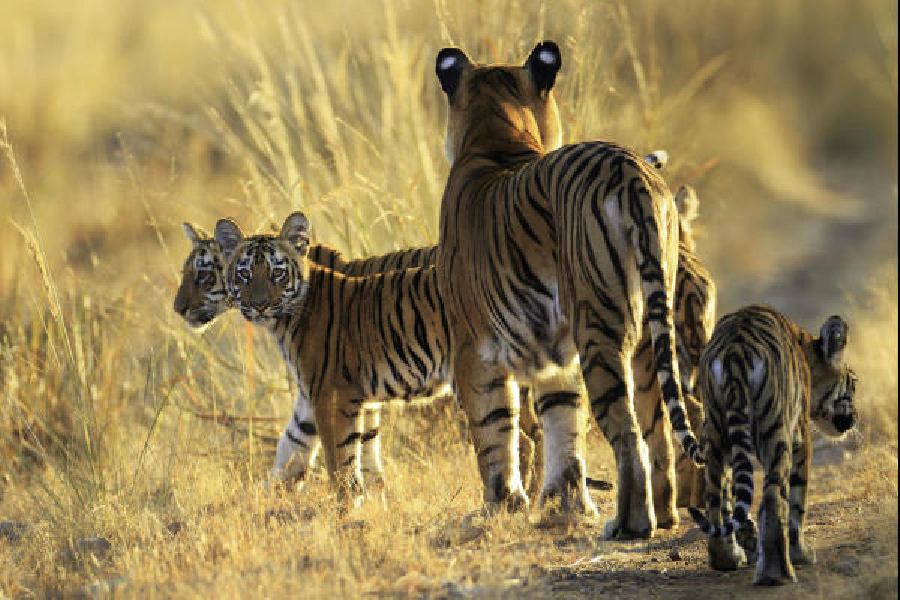Everybody loves a riveting tale. And when a perceptive and empathetic storyteller roams in the wild filming tiger cubs, the story inevitably takes on a heartwarming dimension along with conservation visibility.
That is the forte of cinematographer and filmmaker Subbiah Nallamuthu, whose three-part tiger anthem on Maya — the once reigning tigress of Tadoba Andhari Tiger Reserve in Maharashtra, and her cubs — has become an iconic representation of the lure of the forest.
When we — a group of tourists and myself — entered the Kolara range of Tadoba for a dawn safari not long ago, the naturalist accompanying us pointed to a clearing enveloped in early morning mist, where the jeeps were not allowed. Yet there was movement there; a man who appeared to be setting up base. “That’s Nallamuthu getting ready to film the wildlife,” we were told.
We didn’t get to see Maya at Tadoba but we did see the majestic Veer and Matkasur, Roma and Bijli with their offspring, as well as Chanda and Xylo (Veer’s father).
While the names of tigers continue to fascinate tourists, for forest veterans like Nallamuthu, Maya (Tadoba) and Machli (Ranthambore) have been the primary protagonists.
“I usually keep an eye out for the cubs. My equipment is handled manually and I prefer long-range lens. I know the mother will return to the cubs. When she does, they invariably sniff her mouth. If they react ecstatically, it means she has made a kill. I follow that narrative,” Nallamuthu reveals.
His documentaries are Tiger Dynasty, Tiger Queen and The World’s Most Famous Tiger. In bringing these stories to a global audience, Nallamuthu has raised awareness and advocacy for saving this magnificent species, the Panthera tigris tigris. Nevertheless, Nallamuthu is reluctant to be labelled a conservationist.
He prefers to speak about Maya. He says, “Because her life reflects one of the most complex, and tragic stories I’ve ever filmed.” He continues, “Maya is Maya. A metaphor. A mystery. A mother. A queen of the forest who tried, time and again, to leave behind a legacy. She represented a mother’s desperate, recurring fight to raise a successor in a collapsing ecological system.”
When Nallamuthu began documenting Maya, she had already lost two litters. After the monsoon, she most likely gave birth again. Nallamuthu says, “I finally saw her walking with a female cub. It felt like Maya’s last chance to pass on her territory, her story, her bloodline.”
But the forest had other plans. The pressure Maya faced wasn’t just from predators or poachers, but from a deeply flawed ecological imbalance, as Nallamuthu points out. In many Indian parks, the ideal ratio of one male to three females has been reversed. Today, it is often three males to one female. Males need larger territories, and this imbalance causes territorial pressure, conflict and a direct threat to cub survival. The adult males kill the male cubs.
“For Maya, mating became a survival obligation,” says Nallamuthu. He adds, “But every time she mated to retain her territory, she risked losing her cubs. In the end, she
had to sacrifice motherhood for survival. And ultimately, she vanished.”
The lensman followed her for five years. What he gleaned were hundreds of hours of footage. But broadcasters weren’t interested. Why? “Because there was no celebrity voice or face to boost the ‘numbers’. Because her story isn’t about glamour or spectacle.”
Nallamuthu works with his wife. She quit her job at Isro, as did he, and now she helps her husband archive, organise and preserve.
Nallamuthu is in the process of creating India’s first wildlife storytelling OTT platform, fully self-funded, as a nonprofit initiative under his foundation, Nalla’s Ark. This is
his way of ensuring stories like Maya’s are preserved.
The story of the tiger is not limited to Maya. Nallamuthu says, “I was there when Machli breathed her last — the only person to film the natural death of the most iconic tigress in the world. I followed her daughter Sundari, who disappeared without a trace. I captured Arrowhead’s journey from cubhood to her mysterious end, completing a rare, full-circle narrative. These are stories of love, loss and the haunting beauty of the wild.”










